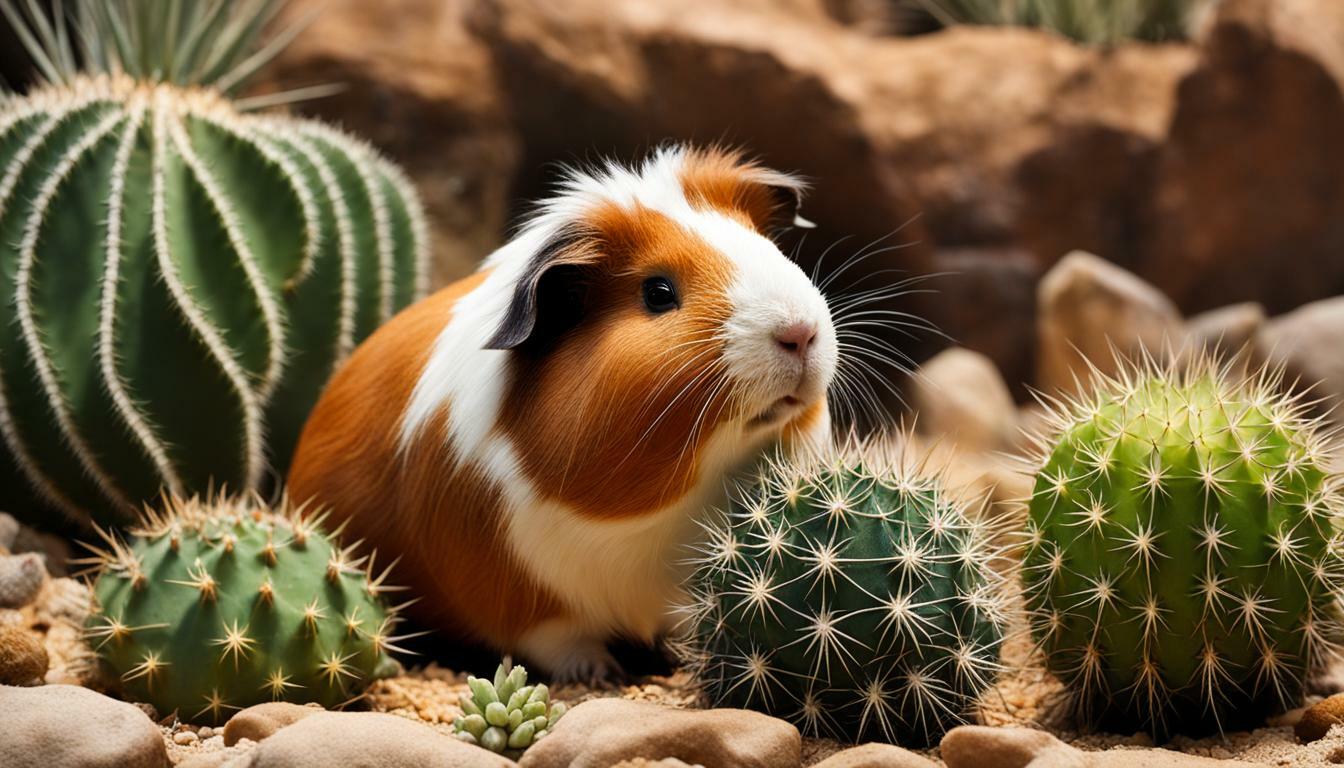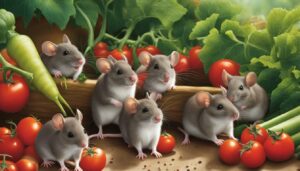Guinea pigs have specific dietary needs, so it’s important to know what foods they can safely eat. In this article, we will explore whether guinea pigs can consume cactus and discuss the importance of a balanced diet for their health.
Key Takeaways:
- Guinea pigs can eat certain types of cactus, such as prickly pear cactus and cactus pads.
- Cactus should be fed to guinea pigs in moderation due to its high sugar content.
- Avoid feeding guinea pigs toxic cactus species like peyote cactus or euphorbia cactus.
- Before feeding cactus to guinea pigs, remove spines and cut the pads into smaller pieces.
- Other safe and nutritious daily vegetables for guinea pigs include lettuce, bell peppers, cilantro, and zucchini.
- Proper nutrition is crucial to prevent health issues in guinea pigs, such as diabetes, kidney problems, and bladder stones.
Guinea Pig Diet: The Basics
A well-rounded guinea pig diet consists of fresh vegetables, fruits, hay, and pellets. These elements provide the necessary nutrients for your guinea pig’s health and well-being. Hay should be available at all times as it aids in digestion and helps wear down their continuously growing teeth. A mix of grass hay, such as timothy hay, and legume hay, such as alfalfa hay, is recommended. Pellets should also be included in their daily diet, but in moderation.
When it comes to vegetables, a variety of options should be offered to ensure a balanced diet. Leafy greens like lettuce, spinach, and kale are excellent choices. Bell peppers, cilantro, and zucchini are also safe and nutritious options. These vegetables provide essential vitamins and minerals that support your guinea pig’s overall health. Fruits can be given as treats but should be given sparingly due to their high sugar content.
It is important to note that while guinea pigs can eat certain types of cactus, it should be fed in moderation. Prickly pear cactus and cactus pads are safe options, but they should be prepared properly before feeding. Remove all spines and cut the pads into smaller pieces to prevent any choking or digestive issues. However, there are cactus species that are toxic to guinea pigs, such as peyote cactus and euphorbia cactus. These should be avoided to ensure the safety of your guinea pig.
| Safe Vegetables | Safe Fruits (in moderation) |
|---|---|
| Lettuce | Apple |
| Spinach | Banana |
| Kale | Strawberry |
| Bell peppers | Blueberry |
| Cilantro | Grapes |
| Zucchini |
Providing a varied and balanced diet is crucial for your guinea pig’s overall health. It helps prevent common health issues such as diabetes, kidney problems, and bladder stones. Always consult with a veterinarian for personalized guidance on your guinea pig’s diet and nutrition. They can provide recommendations based on your guinea pig’s specific needs and ensure they are receiving the proper nutrients for optimal health.
Understanding Cactus and Guinea Pig Health
While cactus can provide certain health benefits to guinea pigs, it’s crucial to be aware of potential risks as well. Guinea pigs can consume certain varieties of cactus, such as prickly pear cactus and cactus pads, which are safe and nutritious additions to their diet. However, moderation is key due to the high sugar content in cactus.
Before offering cactus to your guinea pig, it’s important to take necessary precautions. Remove any spines from the cactus pads and cut them into smaller, manageable pieces. This ensures that your guinea pig can safely chew and digest the cactus without any harm.
Other recommended daily vegetables for guinea pigs include lettuce, bell peppers, cilantro, and zucchini. These vegetables provide essential vitamins and minerals that contribute to a balanced diet for your furry friend. However, it’s important to avoid feeding guinea pigs toxic cactus species like the peyote cactus and euphorbia cactus, as they can be harmful to their health.
Potential Benefits of Cactus for Guinea Pigs
Certain types of cactus can offer health benefits to guinea pigs when given in moderation. Prickly pear cactus, for example, is rich in vitamin C, which is essential for the overall well-being of guinea pigs. Vitamin C helps strengthen their immune system, aids in collagen production, and promotes healthy teeth and bones. Additionally, cactus pads are high in fiber, which supports digestive health and can help prevent common issues like diarrhea and constipation.
| Cactus Type | Health Benefits |
|---|---|
| Prickly Pear Cactus | Rich in vitamin C and fiber |
| Cactus Pads | High in fiber to support digestive health |
While cactus can be a beneficial addition to your guinea pig’s diet, it’s essential to offer it in moderation. Guinea pigs have specific nutritional needs, and an imbalanced diet can lead to various health issues, such as diabetes, kidney problems, and bladder stones. Consult with your veterinarian to ensure your guinea pig’s diet is well-balanced and meets their specific dietary requirements.
Safe Cactus Options for Guinea Pigs
Not all cactus species are safe for guinea pigs, but there are a few options that they can enjoy in moderation. Prickly pear cactus and cactus pads are two varieties that guinea pigs can consume. However, it is important to note that cactus should be given as a treat and not as a staple in their diet due to its high sugar content.
When offering cactus to your guinea pig, it is crucial to take proper precautions. Firstly, remove any spines from the cactus pads to ensure the safety of your pet. Next, slice the pads into smaller, bite-sized pieces to make it easier for your guinea pig to eat. Remember to wash the cactus thoroughly before feeding it to your furry friend to remove any dirt or contaminants.
Table 1: Safe Cactus Options for Guinea Pigs
| Cactus Variety | Benefits |
|---|---|
| Prickly Pear Cactus | Rich in vitamin C and antioxidants |
| Cactus Pads | High in fiber and hydrating |
In addition to cactus, there are several other vegetables that make a healthy addition to a guinea pig’s daily diet. Leafy greens like lettuce and herbs like cilantro provide valuable nutrients. Bell peppers are an excellent source of vitamin C, while zucchini offers a hydrating and low-calorie option. It is important to remember that guinea pigs have sensitive digestive systems, so introducing new foods gradually is recommended to avoid any potential stomach upset.
A balanced diet is crucial for the overall well-being of guinea pigs. Providing them with a wide variety of safe foods helps ensure they receive the necessary nutrients and minimizes the risk of health issues such as diabetes, kidney problems, and bladder stones. Consulting a veterinarian for personalized guidance on your guinea pig’s diet and nutrition is always a wise decision to ensure their optimal health.
Preparing Cactus for Guinea Pig Consumption
Proper preparation of cactus is essential to ensure the safety and digestibility of this food for guinea pigs. Before feeding cactus to your furry friend, take the necessary steps to remove spines and cut the pads into smaller pieces.
Step 1: Removing Spines
Begin by wearing gloves to protect your hands from the spines. Using a sharp knife, carefully trim the spines off the cactus pads. Take extra caution to remove all visible spines as they can cause injury to your guinea pig’s mouth and digestive system.
Step 2: Cutting into Smaller Pieces
After removing the spines, slice the cactus pads into small, bite-sized pieces. This will make it easier for your guinea pig to chew and digest the cactus. Avoid feeding them large chunks as it may pose a choking hazard.
Once the cactus pads are prepared, you can offer them to your guinea pig as a refreshing and nutritious treat. Remember, while guinea pigs can enjoy cactus, it should be fed in moderation due to its high sugar content. Alongside cactus, it’s important to provide a variety of other safe vegetables like lettuce, bell peppers, cilantro, and zucchini to ensure a balanced diet and optimal health for your furry friend.
| Cactus Preparation Steps | Benefits |
|---|---|
| Remove spines | Prevents mouth and digestive injuries |
| Cut into smaller pieces | Facilitates chewing and digestion |
Other Recommended Daily Vegetables for Guinea Pigs
In addition to cactus, guinea pigs can enjoy a variety of vegetables to meet their nutritional needs. Including a mix of different vegetables in their diet helps ensure they receive a well-rounded and balanced meal. Here are some safe and nutritious vegetables that you can offer to your guinea pigs:
- Lettuce: Choose dark, leafy varieties like romaine lettuce or red leaf lettuce. Avoid iceberg lettuce as it has lower nutritional value.
- Bell Peppers: Rich in vitamin C, bell peppers are a great addition to your guinea pig’s diet. Offer a mix of different colored peppers for added variety.
- Cilantro: Guinea pigs love the fresh and fragrant taste of cilantro. This herb is packed with antioxidants and can add some flavor to their meals.
- Zucchini: A hydrating and low-calorie vegetable, zucchini can be sliced into small pieces and served raw. It is a good source of vitamins and fiber.
When introducing new vegetables to your guinea pig’s diet, it is important to do so gradually. Start with small amounts and monitor their reaction. If your guinea pig shows signs of digestive upset or allergies, discontinue feeding them that particular vegetable. Additionally, always ensure that the vegetables offered are fresh, washed thoroughly, and free from pesticides or other harmful substances.
Table: Safe Vegetables for Guinea Pigs
| Vegetable | Benefits |
|---|---|
| Lettuce | Rich in vitamins A and K |
| Bell Peppers | High in vitamin C and antioxidants |
| Cilantro | Contains antioxidants and adds flavor to meals |
| Zucchini | Hydrating and low in calories |
Remember that vegetables should only make up a portion of your guinea pig’s diet. Hay should be the main component of their diet, followed by a measured amount of guinea pig pellets to ensure they receive all the necessary nutrients. Fresh water should always be available for your guinea pig to drink.
Consulting a veterinarian is always recommended to determine the best diet plan for your guinea pig, as individual dietary needs may vary. They can provide guidance tailored to your guinea pig’s specific requirements and help ensure their overall health and well-being.
Potential Health Issues and Guinea Pig Diet
A balanced diet is crucial for maintaining the overall health and well-being of guinea pigs. When it comes to their diet, it’s important to consider the potential health issues that can arise if they are not provided with the right nutrition. By understanding their dietary needs and making informed choices, you can help prevent common health problems in guinea pigs.
Proper Nutrition for Guinea Pigs
Guinea pigs are herbivores, which means their diet should consist primarily of fresh hay, high-quality guinea pig pellets, and fresh vegetables. Leafy greens like lettuce, spinach, and kale are important sources of vitamins and minerals. However, it’s essential to avoid vegetables high in oxalic acid, such as spinach, as these can lead to bladder stones. Instead, opt for low oxalate greens like cilantro, parsley, and romaine lettuce.
In addition to hay and vegetables, guinea pigs require a small amount of fruits as a treat. Examples include small pieces of apple, pear, or melon. However, fruits are high in sugar and should be given sparingly to prevent weight gain and other health issues.
The Dangers of Imbalanced Diet
Providing a nutritionally balanced and varied diet is crucial for keeping your guinea pig healthy. An imbalanced diet lacking in essential nutrients can lead to serious health problems, such as vitamin C deficiency. Guinea pigs are unable to produce their own vitamin C and rely on dietary sources. Without enough vitamin C, they can develop scurvy, a condition that can cause joint pain, bleeding gums, and lethargy.
Preventing Health Issues
To maintain the health of your guinea pig, ensure they have access to fresh, clean water at all times. Water bottles are preferred over bowls, as they prevent contamination. Monitor their food intake and adjust portions accordingly to prevent excessive weight gain or loss. Regular veterinary check-ups are also important to catch any potential health issues early on.
| Safe Vegetables for Guinea Pigs | Unsafe Vegetables for Guinea Pigs |
|---|---|
|
|
Remember, providing a balanced diet and avoiding potentially harmful foods like those high in oxalic acid is essential for the overall health and well-being of your furry friend. By following a guinea pig feeding guide and consulting with a veterinarian, you can ensure your guinea pig receives the necessary nutrients to thrive and live a happy, healthy life.
Toxic Cactus Species to Avoid
Some cactus species can be harmful or even fatal for guinea pigs, so it’s essential to be aware of which ones to avoid. As a responsible guinea pig owner, you should never feed your furry friend any cactus species that are known to be toxic. Two common examples of toxic cactus species are the peyote cactus and euphorbia cactus. These plants contain substances that can be extremely dangerous for guinea pigs when ingested.
Although peyote cactus is known for its hallucinogenic properties in humans, it can be highly toxic to guinea pigs. Ingesting peyote cactus can lead to severe gastrointestinal distress, including vomiting, diarrhea, and dehydration. It can also cause neurological symptoms like confusion and impaired coordination. Similarly, euphorbia cactus, also known as a spurge, contains toxic latex that can cause severe digestive problems and even organ damage in guinea pigs.
Table: Toxic Cactus Species to Avoid
| Cactus Species | Toxicity Level |
|---|---|
| Peyote Cactus | Highly toxic |
| Euphorbia Cactus | Toxic |
It is crucial to remember that not all cactus species are safe for guinea pigs. Always check the specific species before offering it to your pet. If you are unsure about the safety of a particular cactus species, it is best to err on the side of caution and avoid feeding it to your guinea pig. By doing so, you can help protect your pet’s health and ensure they maintain a balanced and nutritious diet.
Moderation in Feeding Cactus to Guinea Pigs
While cactus can be a beneficial addition to a guinea pig’s diet, it should be offered in limited quantities. Guinea pigs are herbivores and require a diet rich in hay, fresh vegetables, and a small amount of fruit. Cactus can provide some nutritional benefits, but it is important to remember that it is high in sugar content, which can be harmful if consumed in excess.
When feeding cactus to guinea pigs, it is essential to prepare it properly. Remove the spines and cut the pads into smaller, bite-sized pieces to prevent choking hazards. It is also crucial to choose the right type of cactus. Prickly pear cactus and cactus pads are generally safe options for guinea pigs, but species like the peyote cactus and euphorbia cactus are toxic and should be avoided.
A balanced guinea pig diet should consist of a variety of safe vegetables in addition to cactus. Lettuce, bell peppers, cilantro, and zucchini are some examples of other recommended daily vegetables for guinea pigs. These vegetables provide important vitamins and minerals that contribute to their overall health and well-being.
| Safe Vegetables for Guinea Pigs | Nutritional Benefits |
|---|---|
| Lettuce | Rich in vitamin A, vitamin C, and fiber |
| Bell peppers | High in vitamin C and antioxidants |
| Cilantro | Contains vitamin K, vitamin C, and calcium |
| Zucchini | Good source of vitamin C, fiber, and hydration |
Proper nutrition is crucial for preventing health issues in guinea pigs. A balanced diet helps maintain healthy weight, digestion, and prevents common problems like diabetes, kidney problems, and bladder stones. However, it is always recommended to consult a veterinarian for personalized guidance on your guinea pig’s specific dietary needs.
Maintaining a Healthy Guinea Pig Diet
To ensure optimal health, it’s important to provide a well-balanced diet that meets the nutritional needs of guinea pigs. Feeding your furry friend a variety of safe and nutritious foods will help them thrive and minimize the risk of health issues. Here are some key factors to consider when maintaining a healthy diet for your guinea pig:
1. Offering a Variety of Vegetables
Guinea pigs should have a daily intake of fresh vegetables to ensure a well-rounded diet. Incorporate a variety of vegetables such as lettuce, bell peppers, cilantro, and zucchini. These vegetables provide essential vitamins and minerals that are vital for your guinea pig’s overall health.
2. Monitoring Portion Sizes
While it’s important to provide a diverse range of vegetables, it’s equally crucial to control portion sizes. Guinea pigs have sensitive digestive systems, and overeating can lead to digestive problems. Offer smaller portions of vegetables and monitor your guinea pig’s intake to prevent obesity and related health issues.
3. Introducing New Foods Gradually
When introducing new foods into your guinea pig’s diet, it’s important to do so gradually. Start with small amounts and observe their reaction. This approach allows you to identify any potential allergies or sensitivities and ensure your guinea pig’s digestive system can handle the new food without causing any discomfort.
Remember, always consult with a veterinarian for personalized guidance on your guinea pig’s diet and specific nutritional needs. By providing a balanced and varied diet, you can promote your guinea pig’s well-being and help them live a happy and healthy life.
| Safe Vegetables for Guinea Pigs | Safe Vegetables for Guinea Pigs |
|---|---|
| Lettuce (romaine, leaf, or butterhead) | Bell Peppers (red, yellow, or green) |
| Cilantro | Zucchini |
| Carrots (in moderation) | Cucumber |
| Spinach (in moderation) | Kale |
Consulting a Veterinarian
It’s always a good idea to consult with a veterinarian for expert advice on your guinea pig’s dietary requirements. Guinea pigs have specific nutritional needs that must be met to ensure their overall health and well-being. By seeking guidance from a professional, you can ensure that your guinea pig’s diet is tailored to their individual needs and prevent any potential health issues.
A veterinarian specializing in small animal or exotic pet care can provide valuable insight into the nutritional requirements of guinea pigs. They can help you determine the appropriate portion sizes, recommend safe and nutritious foods, and guide you in maintaining a balanced diet for your furry friend. Additionally, a veterinarian can offer guidance on introducing new foods to your guinea pig’s diet and address any concerns or questions you may have.
When consulting a veterinarian, be prepared to provide information about your guinea pig’s current diet, including the types of foods they are eating and the quantities. It is also helpful to share your guinea pig’s overall health history, lifestyle, and any specific concerns you may have regarding their diet. This information will assist the veterinarian in customizing a diet plan that meets your guinea pig’s unique needs.
Remember, when it comes to your guinea pig’s nutrition, it’s always better to be safe than sorry. Consulting a veterinarian will ensure that you are providing the best possible care for your furry friend and promoting their overall health and well-being.
Conclusion
In conclusion, while guinea pigs can eat certain types of cactus, such as prickly pear cactus and cactus pads, it is crucial to feed them in moderation and ensure a well-rounded diet to promote their overall health and wellbeing.
Feeding guinea pigs cactus in moderation is important due to its high sugar content. Too much sugar can lead to health issues such as obesity and dental problems. Therefore, it is recommended to offer cactus as an occasional treat rather than a regular part of their diet.
Remember to remove the spines from the cactus pads and cut them into smaller, bite-sized pieces before feeding them to your guinea pigs. This will help prevent any choking hazards and make the cactus easier for them to consume.
In addition to cactus, there are other safe and nutritious vegetables that you can include in your guinea pig’s daily diet. Lettuce, bell peppers, cilantro, and zucchini are some of the recommended options that provide essential vitamins and minerals for their wellbeing.
By maintaining a balanced diet and ensuring proper nutrition for your guinea pigs, you can help prevent common health issues such as diabetes, kidney problems, and bladder stones. If you have any specific concerns about your guinea pig’s diet, it is always best to consult with a veterinarian for personalized guidance.
FAQ
Can guinea pigs eat cactus?
Yes, guinea pigs can eat certain types of cactus, such as prickly pear cactus and cactus pads. However, it is important to feed them cactus in moderation due to its high sugar content.
What types of cactus are safe for guinea pigs?
Prickly pear cactus and cactus pads are safe options for guinea pigs to consume.
How should I prepare cactus for my guinea pig?
It is necessary to remove the spines and cut the cactus pads into smaller pieces before feeding them to your guinea pig.
Are there any other vegetables I can feed my guinea pig?
Yes, other recommended vegetables for guinea pigs include lettuce, bell peppers, cilantro, and zucchini.
Why is proper nutrition important for guinea pigs?
Proper nutrition is crucial for preventing health issues in guinea pigs such as diabetes, kidney problems, and bladder stones.
Are there any cactus species that are toxic to guinea pigs?
Yes, cactus species like peyote cactus and euphorbia cactus are toxic to guinea pigs and should be avoided.
How much cactus should I feed my guinea pig?
Cactus should be fed to guinea pigs in moderation due to its high sugar content. Consult with a veterinarian for personalized guidance on portion control.
Can guinea pigs eat cactus on a daily basis?
It is recommended to provide a variety of foods in a guinea pig’s diet, including cactus, but not exclusively cactus.
Should I consult a veterinarian about my guinea pig’s diet?
Yes, it is advisable to consult a veterinarian for personalized guidance on your guinea pig’s diet and nutritional needs.




